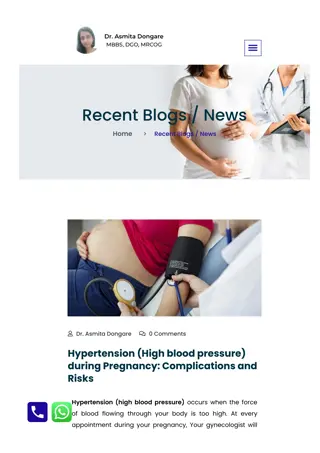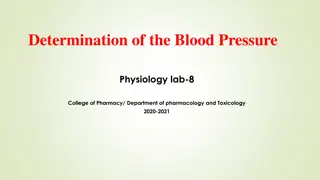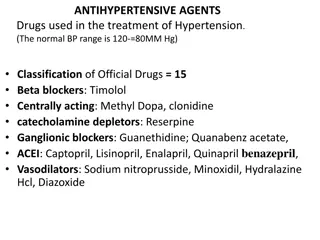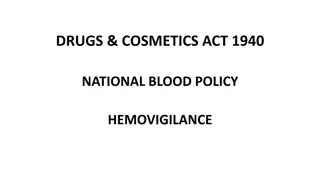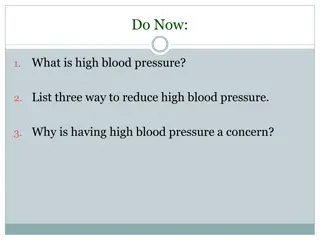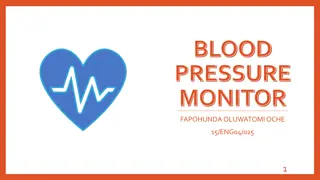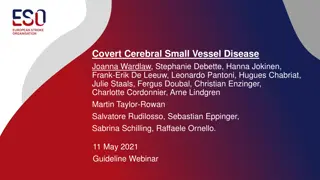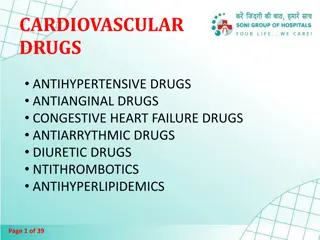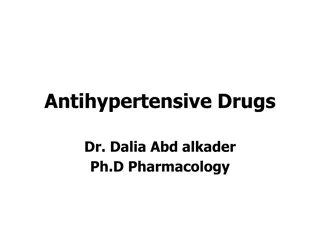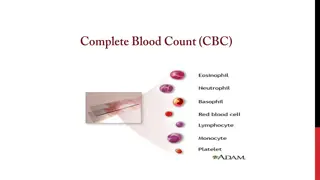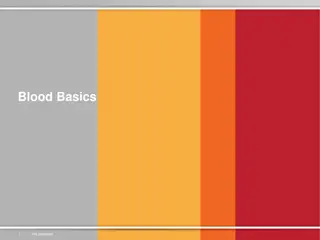Antihypertensive Drugs and Blood Pressure Control
Antihypertensive drugs play a crucial role in managing high blood pressure, which is often a result of various factors including increased vascular tone. Understanding the mechanisms behind hypertension and the control of blood pressure through baroreceptors, the sympathetic nervous system, and renin-angiotensin system is essential for effective treatment and prevention strategies. Explore the etiology of hypertension and the importance of environmental and lifestyle factors in its development.
Download Presentation

Please find below an Image/Link to download the presentation.
The content on the website is provided AS IS for your information and personal use only. It may not be sold, licensed, or shared on other websites without obtaining consent from the author.If you encounter any issues during the download, it is possible that the publisher has removed the file from their server.
You are allowed to download the files provided on this website for personal or commercial use, subject to the condition that they are used lawfully. All files are the property of their respective owners.
The content on the website is provided AS IS for your information and personal use only. It may not be sold, licensed, or shared on other websites without obtaining consent from the author.
E N D
Presentation Transcript
AL AL- -MUSTAQBAL UNIVERSITY COLLEGE MUSTAQBAL UNIVERSITY COLLEGE DEPARTMENT OF ANESTHETIC TECHNOLOGY DEPARTMENT OF ANESTHETIC TECHNOLOGY PHARMACOLOGY PHARMACOLOGY DONE BY : DR. ABDULLA K RAHEE DONE BY : DR. ABDULLA K RAHEEM
Antihypertensive drugs Blood pressure is elevated when systolic blood pressure exceeds 130 mm Hg and diastolic blood pressure exceeds 80 mm Hg. Hypertension results from increased peripheral vascular arteriolar smooth muscle tone, which leads to increased arteriolar resistance and reduced capacitance of the venous system.
Antihypertensive drugs Systolic mmHg 120 Antihypertensive drugs Systolic mmHg status Normal Stage1 hypertension status Normal Stage1 hypertension Diastolic mmHg 80 Diastolic mmHg and or 80 - 89 130 - 139 or 90 Stage2 hypertension Stage2 hypertension 140
Etiology of hypertensions Etiology of hypertensions Hypertension may occur secondary to other disease processes. more than 90% of patients have essential hypertension (hypertension with no identifiable cause). The prevalence of hypertension increases with age. Persons with diabetes, obesity, or disability status are all more likely to have hypertension than those without these conditions. In addition, environmental factors, such as a stressful lifestyle, high dietary intake of sodium, and smoking, may further predispose an individual to hypertension.
Mechanisms for controlling blood pressure A A- - Baroreceptors and the sympathetic nervous system Mechanisms for controlling blood pressure Baroreceptors and the sympathetic nervous system Baro reflexes act by changing the activity of the sympathetic and parasympathetic nervous system. They are responsible for the rapid, moment-to-moment regulation of blood pressure. A fall in blood pressure causes pressure-sensitive neurons (baroreceptors in the aortic arch and carotid sinuses) to send fewer impulses to cardiovascular centers in the spinal cord. This prompts a reflex response of increased sympathetic and decreased parasympathetic output to the heart and vasculature, resulting in vasoconstriction and increased cardiac output. These changes result in a compensatory rise in blood pressure.
B B- - Renin The kidney provides long-term control of blood pressure by altering the blood volume. Baroreceptors in the kidney respond to reduced arterial pressure by releasing the enzyme renin Low-sodium intake and greater sodium loss also increase renin release. Renin converts angiotensinogen to angiotensin I, which is converted in turn to angiotensin II, in the presence of angiotensin converting enzyme (ACE). Angiotensin II is a potent circulating vasoconstrictor, constricting both arterioles and veins, resulting in an increase in blood pressure. Renin- -angiotensin angiotensin- -aldosterone system aldosterone system
TREATMENT STRATEGIES The goal of antihypertensive therapy is to reduce cardiovascular and renal morbidity and mortality. For most patients, the blood pressure goal when treating hypertension is a systolic blood pressure of less than 130 mm Hg and a diastolic blood pressure of less than 80 mm Hg. Current recommendations are to initiate therapy with a thiazide diuretic, ACE inhibitor, angiotensin receptor blocker (ARB), or calcium channel blocker. However, initial drug therapy choice may vary depending on the guideline TREATMENT STRATEGIES
Drugs used to treat hypertension Drugs used to treat hypertension 1- DIURETICS For all classes of diuretics, the initial mechanism of action is based upon decreasing blood volume, which ultimately leads to decreased blood pressure. Routine serum electrolyte monitoring should be done for all patients receiving diuretics. 1 1- -Thiazide diuretics DIURETICS Thiazide diuretics 2- Loop diuretics 3 Loop diuretics 3- - Potassium Potassium- -sparing diuretics sparing diuretics
2- ADRENOCEPTOR The -blockers reduce blood pressure primarily by decreasing cardiac output . They may also decrease sympathetic outflow from the central nervous system (CNS) and inhibit the release of renin from the kidneys, thus decreasing the formation of angiotensin II and the secretion of aldosterone. Selective blockers of 1 1 receptors, such as metoprolol and atenolol, are among the most commonly prescribed -blockers 1 1 receptors, which also increases the production of nitric oxide, leading to vasodilation. ADRENOCEPTOR- -BLOCKING AGENTS BLOCKING AGENTS blockers. Nebivolol is a selective blocker of
3- ACE inhibitors ACE inhibitors such as captopril , enalapril , and lisinopril are recommended as first-line treatment of hypertension in patients with a variety of compelling indications, including high coronary disease risk or history of diabetes, stroke, heart failure, myocardial infarction, or chronic kidney disease. The ACE inhibitors lower blood pressure by reducing peripheral vascular resistance . These drugs block the enzyme ACE, which cleaves angiotensin I to form the potent vasoconstrictor angiotensin II ACE inhibitors
Angiotensin II receptor blockers The ARBs, such as losartan and irbesartan block the AT1 receptors, decreasing the activation of AT1 receptors by angiotensin II. Their pharmacologic effects are similar to those of ACE inhibitors in that they produce arteriolar and venous dilation and block aldosterone secretion, thus lowering blood pressure and decreasing salt and water retention. ARBs do not increase bradykinin levels. They may be used as first-line agents for the treatment of hypertension, especially in patients with a compelling indication of diabetes, heart failure, or chronic kidney disease Adverse effects are similar to those of ACE inhibitors, although the risks of cough and angioedema are significantly decreased. ARBs should not be combined with an ACE inhibitor for the treatment of hypertension due to similar mechanisms and adverse effects. These agents are also teratogenic and should not be used by pregnant women. Angiotensin II receptor blockers
Calcium channel blockers Calcium channel blockers are a recommended first-line treatment option in black patients. They may also be useful in hypertensive patients with diabetes or stable ischemic heart disease. High doses of short-acting calcium channel blockers should be avoided because of increased risk of myocardial infarction due to excessive vasodilation and marked reflex cardiac stimulation. Calcium channel blockers
- -ADRENOCEPTOR -Adrenergic blockers used in the treatment of hypertension include prazosin, doxazosin and terazosin . These agents produce a competitive block of 1-adrenoceptors. They decrease peripheral vascular resistance and lower arterial blood pressure by causing relaxation of both arterial and venous smooth muscle. These drugs cause only minimal changes in cardiac output, renal blood flow, and glomerular filtration rate. Therefore, long-term tachycardia does not occur, but salt and water retention does. Reflex tachycardia and postural hypotension often occur at the onset of treatment and with dose increases, requiring slow titration of the drug in divided doses. Due to weaker outcome data and their side effect profile, -blockers are no longer recommended as initial treatment for hypertension but may be used for refractory cases. Other a1-blockers with greater selectivity for the prostate are used in the treatment of benign prostatic hyperplasia. ADRENOCEPTOR- -BLOCKING AGENTS BLOCKING AGENTS
and Labetalol and carvedilol block 1, indicated in the treatment of heart failure and hypertension. It has been shown to reduce morbidity and mortality associated with heart failure. Labetalol is used in the management of gestational hypertension and hypertensive emergencies. and adrenoceptor adrenoceptor- -blocking agents blocking agents 1, 1 1, and 2 receptors. Carvedilol is
Centrally acting adrenergic drugs Clonidine Clonidine acts centrally as an -2 agonist to produce inhibition of sympathetic vasomotor centers, decreasing sympathetic outflow to the periphery. This leads to reduced total peripheral resistance and decreased blood pressure. Clonidine is used primarily for the treatment of hypertension that has not responded adequately to treatment with two or more drugs. Clonidine does not decrease renal blood flow or glomerular filtration and, therefore, is useful in the treatment of hypertension complicated by renal disease. Clonidine is well absorbed after oral administration and is excreted by the kidney. It is also available in a transdermal patch. Adverse effects hypertension occurs following abrupt withdrawal of clonidine. The drug should, therefore, be withdrawn slowly if discontinuation is required. Centrally acting adrenergic drugs Clonidine Adverse effects include sedation, dry mouth, and constipation . Rebound
Methyldopa Methyldopa is an - -2 2 agonist that act centrally to diminish adrenergic outflow from the CNS. The most common side effects of methyldopa are sedation and drowsiness. Its use is limited due to adverse effects and the need for multiple daily doses. It is mainly used for management of hypertension in pregnancy, where it has a record of safety. Methyldopa



